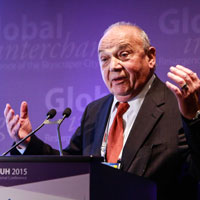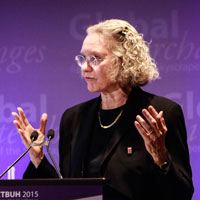Session 3e: The Super Slim
Chair: Judith Dupré, www.judithdupre.com
Speakers
Click a presenter to see a video of their presentation, and the accompanying paper and PowerPoint presentation.

Silvian Marcus
Director of Building StructuresWSP
“The New Supers: Super-Slender Towers of New York”
Session Summary
Slender, supertall, luxury residential skyscrapers have dominated much of the conversation surrounding New York’s current high-rise building boom. These structures have received praise for their architectural ingenuity and considerable criticism for their apparent disregard for affordability and local context. For better or worse, they have sparked a debate about height that will undoubtedly impact future development in the city. Presentations in this session focused on the myriad aspects of super slim buildings, including their detailed engineering solutions as well as a review of the rhetoric employed by critics to disparage them.
Carol Willis, President, The Skyscraper Museum, began the presentation stating that New York City has created a new generation of super slim buildings, a typology that has grown out of a collection of attributes which together are unique to Manhattan, including zoning limitations on Floor Area Ratio (FAR) and air rights transfers coupled with a large global demand for real estate investment in New York. Willis noted that a renewed desire for residences located near Central Park and the exclusivity of a high floor with unobstructed views is driving demand for developers to propose very tall, very slender towers while using the existing zoning process to expedite approvals. Willis then concluded with a review of the controversy perpetuated by critics who lambast shadows cast into Central Park, the often unoccupied nature of the condo units, no provision of affordable housing, and the lack of public transparency within as-of-right zoning approvals. While countering the criticisms, she noted these towers are continuing to be proposed and are likely the landmarks of tomorrow.
Next, Silvian Marcus, Director of Building Structures, WSP Group, discussed the challenges of engineering a very slender tower and the means necessary to reduce the sway of such buildings to maintain a high level of comfort. Marcus reaffirmed that luxury units are what makes these buildings economical to construct, noting that high ceilings actually reduce the area needed for stairways by 10 percent and that larger condominiums with a lower overall unit count reduces the amount of elevators needed to service the building. Marcus concluded with a discussion on the innovative structural design of the MoMa tower, which had the structure of its cross bracing redesigned as concrete after the cost estimates for steel came in higher than anticipated.
The last presentation by Stephen DeSimone, President, DeSimone Consulting Engineers, started with a desire for the CTBUH to begin ranking “mega slim buildings like mega tall towers” and further emphasized that tall and slender is a trend that’s here to stay. He noted that while New York is in the midst of 20-year boom in tall building construction, other cities like Miami that lack a tradition of supertall buildings now seeing 1,000-foot proposals. DeSimone emphasized that the expansive views from higher floors command the highest prices per square foot and expressed the importance of having as much occupiable space as possible in the upper half of a building. He then concluded with a description of two projects in New York that were intentionally designed to have larger floor plates at the top than the bottom.






